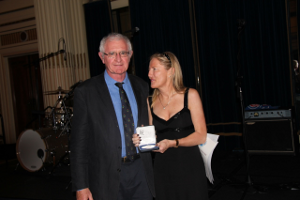Dr Ian Calder - Consultant Anaesthetist
Citation for Dr Ian Calder
 I first met Ian in 1987 at the first national fibreoptic intubation symposium organised by Dr Ray Towey. Ian was one of the pioneers in incorporating this technique into his neuro-anaesthesia practice and Ray had recognised his talent and skill. Building a ‘syllabus’ around this useful airway management equipment, little used then in the UK despite being described 20 years earlier, required experts who knew what it was that other people should know. Ian was foremost amongst this group. In the early days he was quick to point out that there were no experts, a controversial view at the time when wisdom was imparted through experts writing in textbooks. How Ian detested ‘book-knowledge’ whereby information from past textbooks was recycled without critical input from busy practising clinicians. It proved to be an influential stance and we have tried to follow his lead.
I first met Ian in 1987 at the first national fibreoptic intubation symposium organised by Dr Ray Towey. Ian was one of the pioneers in incorporating this technique into his neuro-anaesthesia practice and Ray had recognised his talent and skill. Building a ‘syllabus’ around this useful airway management equipment, little used then in the UK despite being described 20 years earlier, required experts who knew what it was that other people should know. Ian was foremost amongst this group. In the early days he was quick to point out that there were no experts, a controversial view at the time when wisdom was imparted through experts writing in textbooks. How Ian detested ‘book-knowledge’ whereby information from past textbooks was recycled without critical input from busy practising clinicians. It proved to be an influential stance and we have tried to follow his lead.
Ian is undoubtedly the most erudite and respected person I have met. His tireless teaching, speaking, chairing, writing, editing and researching have led to his position as one of the top airway management authorities in the world. His role as a teacher and mentor of trainees, skill in clinical anaesthesia and calm authority can all be attested to at the highest level. Indeed it was these attributes that made him the only possible moderator for the NAP4 study. Working alone, he was the person trusted to bring judgement in questionable cases as to whether they should be reported or were outside the scope of the project. His love of history has enriched our appreciation of our heritage and his recent meeting with Dr Peter Murphy and talk at the Association meeting on the first description of fibreoptic intubation are very typical activities. But I would like to mention three specific areas in which Ian’s contribution has been particularly notable.
Airway management in the 1980s had little formal structure as we know it now, but one under-pinning was the prediction of difficulty that allowed you to avoid trouble. Few people have submitted the concept of prediction of difficulty, in effect mass screening, to such close critical analysis through personal research and observation. Our current understanding of the benefits and limitations of preoperative assessment owes much to Ian’s work but also to his honesty in admitting that few understood the statistical description of the worth of a particular test. Released from having to hide our own rather limited knowledge of sensitivity, specificity and positive predictive value, Ian led us out of the haze with his adoption and use of the likelihood ratio. With more understanding of the limitations of bedside tests we have correctly raised the prominence of a management strategy to cope with the often unanticipated problems.
Ian has consistently challenged orthodox thinking particularly over whether there are any fixed rules which direct that we must behave in a particular way in certain circumstances. Who can forget his published series recounting the disasters of trying to intubate under deep inhalational anaesthesia at a time when this was the textbook technique. But it is his most recent assault on the practice of not giving muscle relaxants until successful facemask ventilation has been demonstrated that has sealed his reputation. Who would wish to oppose Ian in a courtroom with his painstaking research into the history and evidence of why we adopt various practices and his great intellect in presenting his case. Characteristically, Ian’s points are often very specific and require thorough reading and thought. Nobody within airway management has remained unstimulated by his views and many have come to realise their truth through self-discovery.
The third area is very topical now after NAP4, whether adverse events are due to ‘bad’ people who behave aberrantly and need to be rooted out or ‘good’ people who behave imperfectly in certain circumstances. Ian has been fairly steadfast throughout his career in not judging his colleagues too harshly pointing out that none of us know how we would act in some highly stressed situations. If competence can be defined as knowledge, skills and behaviour we have spent over 20 years concentrating on knowledge and skills. Perhaps it should now be the era of addressing the human and non-technical factors that influence outcome. Ian has usually been ahead of us all.
Dr Ian Calder was one of the founding group of this Society and an early Executive Officer. His contribution to how an anaesthetist thinks about or approaches airway management exceeds all others and he is a very worthy recipient of the Macewen Medal.
Dr Adrian Pearce
October 2011
